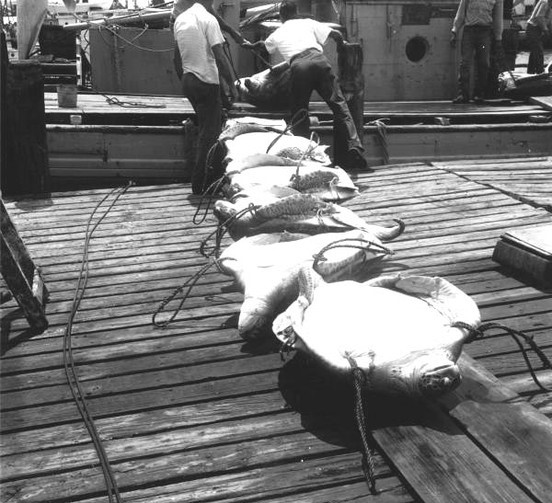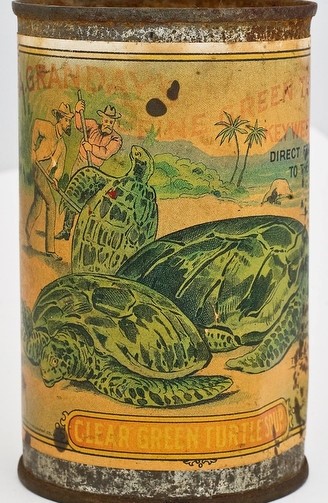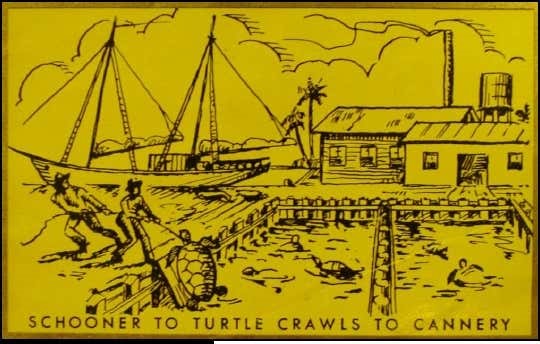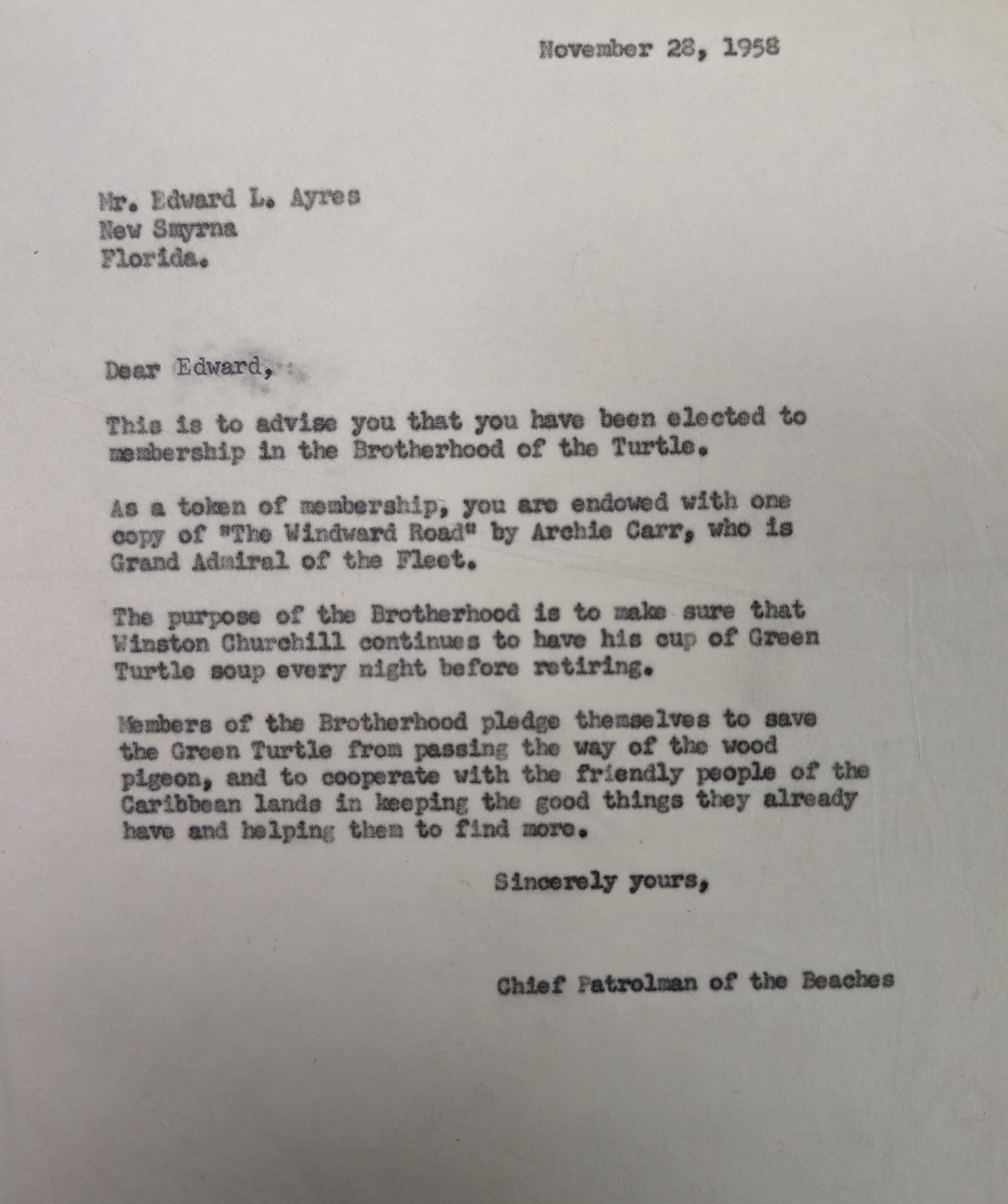The Early History of Sea Turtle Conservation Regulation and Policy in Florida, Part II
The Early History of Sea Turtle Conservation Regulation and Policy in Florida, Part II
Thomas T. Ankersen, Professor Emeritus
University of Florida Levin College of Law
Image credit: Mel Fisher Maritime Museum, Key West, Florida
Introduction
In our previous blog, we discussed the alarming report from the U.S. Fisheries Commissioner on the State of Florida Fisheries – including sea turtles – in 1897. Despite the State’s population being just over a million at the time, with minimal land-based pollution and vast seagrass meadows, some fisheries were already showing signs of decline. The Commissioner specifically noted a decrease in sea turtle catch across the state and recommended a statewide ban on sea turtle harvest during the months of May through October to prevent their extinction.
However, the State continued to regulate the turtle fishery for most of the 20th century, until the Commissioner’s warning nearly came true. By the time the State took action, sea turtles in Florida were commercially extinct and on the brink of biological extinction. In the second half of the century, scientists, led by Dr. Archie Carr, began to unravel the mysteries of sea turtle biology and behavior, and a small group of advocates emerged to support his work and sea turtle conservation efforts.
Early 20th Century Regulations: The Fisheries Focus


Image credit: Mel Fisher Maritime Museum, Key West, Florida
In 1907, the Florida Legislature passed a statewide law banning the harvest of green and loggerhead sea turtles during the nesting season, but only while the turtles were on the beach, with no mention of egg collection.[2] In 1913, the first of many local fishery laws affecting sea turtles was enacted in Dade County,[3] which was experiencing rapid population growth at the time. This law prohibited most net fishing in Biscayne Bay but allowed for large mesh nets to continue capturing sea turtles. It also required non-citizens to obtain a county license for “for-hire” fishing, which typically includes charter fishing for turtles. Commercial fishing also required a license and applied to all individuals in the county.
After a nearly three-decade pause in sea turtle legislation, a statewide bill was passed in 1941 that mirrored the 1907 law. This law established a closed season for the harvest of all loggerhead and green turtles during the months of May, June, July, and August, while the turtles were ”out of the waters or upon the beaches of the state.” [4] It did not address nests or eggs. This statute was incorporated into the State’s new continuous revision system of statutory codification, which began in 1941.[5] The law governing sea turtles was found in Chapter 374, Florida Statutes, titled Saltwater Fisheries (until it was later moved to Chapter 370, Florida Statutes). This law was reenacted in 1949 due to a post-war pause in the continuous revision process.[6] Section 374.16, as amended, formed the basis for what is now known as the Florida Marine Turtle Protection Act.

Image credit: Mel Fisher Maritime Museum, Key West, Florida
Legislating Sea Turtle Conservation through “Whac-a-Mole”
In 1941, a local bill was passed to protect sea turtles both in the water and on land during the months of May, June, July, and August. The bill made it illegal to “take, destroy, mutilate, disturb, or interfere with any turtle egg or eggs, nest or nests, or any loggerhead or green turtle” during these months. The law applied to all “Counties in the Fourth Congressional District have a population greater than 39,000.” [7] At the time, this included Dade, Broward, and Palm Beach Counties. In addition to including nests and eggs, which Section 374.16 had failed to do, this local law also prohibited harvest “from the water adjacent to and touching the State of Florida” in the three counties to which it applied.The first time in-water harvest was prohibited in Florida was in 1941, when the native South Florida bill was passed. This marked the beginning of a trend in Florida fisheries legislation that addressed sea turtles, along with other species. The legislature took a reactive approach, addressing declines in sea turtle populations on a county-by-county basis. This approach also saw the passing of local bills that were not identified by county names, but rather by their population. This was likely due to concerns over the constitutionality of geographically specific local bills. However, this practice was not consistent when it came to sea turtle legislation.
In 1951, a law was passed in Brevard County, which is a major nesting site for Loggerhead turtles. This law was similar to the 1941 legislation, but it expanded the protected period for nests and eggs to include September and October, recognizing the importance of these months for nesting. In 1953, as part of a reorganization of the Florida Statutes, a new section was added that made it illegal to disturb or destroy any marine turtle nest or eggs at any time. This was a significant change from the previous law, which only addressed eggs and nests and left the protection of turtles on nesting beaches or in-water to local laws.
In the following years, more local laws were passed that addressed sea turtles in specific counties, including Flagler, Brevard, St. Johns, and Sarasota. This marked the first time that sea turtle populations on the west coast were addressed. In 1957, the statewide law was amended to include in-water protection for all sea turtle species, not just Loggerheads and Greens. This was also the first time that Hawksbill, Leatherback, and Atlantic Ridley turtles were protected. As counties continued to grow, new laws were passed to address the changing populations and conservation efforts. These laws often mirrored the statewide law, but there were also some unique restrictions, such as the prohibition of spearfishing in certain counties.
During this time, a young zoologist named Archie Carr began to focus his research on sea turtles and made significant contributions to the understanding of their life history and behavior. His research, along with that of his colleagues and students, shed light on important aspects of sea turtle biology that would later inform policy decisions. However, by the time Carr began his research, nesting Green turtles had already disappeared from Florida’s beaches. It wasn’t until 1957 and 1958 that the first confirmed reports of nesting Green turtles were recorded in Indian River and Martin counties. This led Carr to believe that Florida’s Atlantic coast was once a major nesting site for Green turtles.
While Carr is often credited as the pioneer of Florida sea turtle science, others also played important roles in the early efforts to understand and manage the fishery. Robert Ingle, a prominent figure in Florida fisheries management, was also involved in sea turtle research and played a significant role in the development of state sea turtle policy. Ingle was the first marine biologist hired by the State of Florida and would go on to become the Director of Research for the Florida State Board of Conservation Marine Laboratory, which is now known as the Florida Fish and Wildlife Research Institute. He was a strong advocate for conservation and fisheries management and conducted research on sea turtles.
In conclusion, the 1950s saw significant developments in Florida’s sea turtle legislation and the rise of modern sea turtle science. While there were still challenges and gaps in protection, these early efforts laid the foundation for future conservation and management efforts.10(1) Fla. L. Rev. 98—104 (1957).
[9] Act of 1949, ch. 25035-No. 597, 1949 Fla. Legal guidelines 343 (“An ACT to Prohibit the Taking of Sea Turtles and the Taking of Sea Turtle Eggs on the Seashores of the State of Florida, and to Prescribe Penalties for the Violation Thereof”).
[10] Act of 1953, ch. 28221-No. 597, 1953 Fla. Legal guidelines 343 (“An ACT to Prohibit the Taking of Sea Turtles and the Taking of Sea Turtle Eggs on the Seashores of the State of Florida, and to Prescribe Penalties for the Violation Thereof”).
[11] Act of 1955, ch. 29969-No. 597, 1955 Fla. Legal guidelines 343 (“An ACT to Prohibit the Taking of Sea Turtles and the Taking of Sea Turtle Eggs on the Seashores of the State of Florida, and to Prescribe Penalties for the Violation Thereof”).
[12] Act of 1957, ch. 30769-No. 597, 1957 Fla. Legal guidelines 343 (“An ACT to Prohibit the Taking of Sea Turtles and the Taking of Sea Turtle Eggs on the Seashores of the State of Florida, and to Prescribe Penalties for the Violation Thereof”).
[13] Act of 1959, ch. 31657-No. 597, 1959 Fla. Legal guidelines 343 (“An ACT to Prohibit the Taking of Sea Turtles and the Taking of Sea Turtle Eggs on the Seashores of the State of Florida, and to Prescribe Penalties for the Violation Thereof”).
[14] Act of 1961, ch. 61-225, 1961 Fla. Legal guidelines 343 (“An ACT to Prohibit the Taking of Sea Turtles and the Taking of Sea Turtle Eggs on the Seashores of the State of Florida, and to Prescribe Penalties for the Violation Thereof”).
[15] Act of 1963, ch. 63-33, 1963 Fla. Legal guidelines 343 (“An ACT to Prohibit the Taking of Sea Turtles and the Taking of Sea Turtle Eggs on the Seashores of the State of Florida, and to Prescribe Penalties for the Violation Thereof”).
[16] Act of 1965, ch. 65-20, 1965 Fla. Legal guidelines 343 (“An ACT to Prohibit the Taking of Sea Turtles and the Taking of Sea Turtle Eggs on the Seashores of the State of Florida, and to Prescribe Penalties for the Violation Thereof”).
[17] Act of 1967, ch. 67-20, 1967 Fla. Legal guidelines 343 (“An ACT to Prohibit the Taking of Sea Turtles and the Taking of Sea Turtle Eggs on the Seashores of the State of Florida, and to Prescribe Penalties for the Violation Thereof”).
[18] Act of 1969, ch. 69-20, 1969 Fla. Legal guidelines 343 (“An ACT to Prohibit the Taking of Sea Turtles and the Taking of Sea Turtle Eggs on the Seashores of the State of Florida, and to Prescribe Penalties for the Violation Thereof”).
[19] Archie Carr, The Windward Road (1956).
[20] Frederick R. Davis, The Man Who Saved Sea Turtles Archie Carr and the Origins of Conservation Biology (2007).
[18] In his later career, he faced the challenge of dealing with the lack of understanding of sea turtle biology and behavior while trying to maintain a declining fishery. This was largely due to the lack of knowledge about sea turtles.
The 1950s and the Beginning of Sea Turtle Advocacy
As scientists like Archie Carr continued to uncover the mysteries of sea turtle biology and behavior, which contributed to the unsustainable fishery, public concern for the well-being of sea turtles grew. Carr’s award-winning book, ”The Windward Road,”[19] was accessible to a wide audience and served as the catalyst for the formation of the “Brotherhood of the Green Turtle” in 1958. Inspired by Carr’s book, Joshua Powers created the Brotherhood to support Carr’s work and raise awareness about the plight of sea turtles. Carr’s biographer, Frederick Rowe Davis, credits the group for creating a space for sea turtle advocacy, allowing Carr to continue his government-funded research without being hindered by conservation politics.[20] The group initially focused on international efforts and played a role in protecting the nesting beach in Tortuguero, Costa Rica, which was Carr’s main research site. Carr believed that Tortuguero was the source of the green turtle population throughout the Caribbean, including Florida. The Brotherhood of the Green Turtle eventually evolved into the Caribbean Conservation Corporation (CCC), and later the Sea Turtle Conservancy (STC), based in Gainesville, Florida. CCC/STC became a powerful force in shaping sea turtle policy in Florida, the United States, and internationally.

A carbon copy of Joshua Power’s initial invitation to the Brotherhood of the Green Turtle. Image credit: Sea Turtle Conservancy
Conclusion
The 20th century proved to be a futile attempt at managing the sea turtle fishery in Florida due to the lack of understanding of their biology and behavior. County by county, the state implemented local laws in an effort to restrict the harvest of sea turtles and their eggs, but to no avail. The taking of turtles and eggs continued to be widespread. In the 1950s, the plight of sea turtles caught the attention of biologists who slowly began to unravel the science necessary for effective management. It became clear that sea turtles were wide-ranging, vulnerable to exploitation in foreign waters and on foreign shores, and had a slow maturation process. At the same time, the world’s first non-governmental sea turtle advocacy group, the Brotherhood of the Green Turtle, was formed to support the work of Dr. Archie Carr and advocate for sea turtles throughout their range. By 1970, the tide began to turn – just in time.
Coming Next: “A Fishe No More”
Our final early history blog will explore the transition of sea turtle policy from one based on fisheries management to one focused on protected species management. This transition did not occur in a vacuum. Around the world, the threat of species extinction loomed, and policymakers faced a growing chorus of environmental activism. Against this backdrop, sea turtles in Florida would soon become ”A Fishe No More.”
Digging Deeper
Fre” name=”_edn11″>[xi] Act of 1957, ch. 57-771, 1957 Fla. Legal guidelines 1091 (An ACT regarding Saltwater Fisheries Conservation; prohibiting the taking, killing, possessing or mutilating of any sea turtle inside a sure distance from the seashores of Florida throughout a sure interval and offering penalties for violations) (codified at Fla. Stat. § 370.12 (1957)).
[xii] Act of 1959, Ch.59-927, 1959 Fla. Legal guidelines 498—99 (An ACT regarding all counties having a inhabitants of not lower than six thousand 100 (6,100) nor greater than six thousand 300 (6,300) based on the most recent official state-wide decennial census; prohibiting the gigging or spearing of inexperienced turtles; offering a penalty; offering an efficient date).
[xiii] Act of 1963, ch. 63-1662, 1963 Legal guidelines of Florida 2328—29 (“An ACT relating to and prohibiting spearfishing in salt waters lying in and adjacent to certain areas of Monroe County providing for penalty; providing for a referendum providing an effective date”).
[xiv] Archie F. Carr, The Zoogeograpy and Migrations of Sea Turtles, 12 months Guide of the Am. Phil. Soc’y, 138—40 (1954).
[xv] Archie F. Carr & David Okay. Caldwell, The Ecology and Migrations of Sea Turtles, 1: Outcomes of Subject Work in Florida, 1955, Am. Museum Novitates; no. 1793. (1956).
[xvi] Archie F. Carr & Robert Ingle, The Inexperienced Turtle (Chelonia Mydas Mydas) in Florida, 9(3) Bull. of Marine Sci. of the Gulf and Caribbean 315-20. (1959).
[xvii] Stephen P. Geiger, In Memoriam Robert M. Ingle 1917–1997, 42(3) J. of Shellfish Rsch. 343—50 (2023).
[xviii] Robert M. Ingle & F. G. Walton Smith, Sea turtles and the turtle trade of the West Indies, Florida, and the Gulf of Mexico (1949).
[xix] Archie F. Carr, The Windward Street Adventures of a Naturalist on Distant Caribbean Shores (1956).
[xx] Frederick R. Davis, The Man Who Saved Sea Turtles Archie Carr and the Origins of Conservation Biology (2007).
References
This project was funded (in full or in part) by a grant awarded from the Sea Turtle Grants Program. The Sea Turtle Grants Program is funded from proceeds from the sale of the Florida Sea Turtle License Plate. Learn more at www.helpingseaturtles.org.
[i] John J. Brice, The Fish and fisheries of the coastal waters of Florida: Letter from the commissioner of fish and fisheries, transmitting in response to Senate resolution of February 15, 1895, a report of the fish and fisheries of the coastal waters of Florida, S. Doc. No. 54-100 (1897) (available at Biodiversity Heritage Library, https://www.biodiversitylibrary.org/bibliography/4916).
[ii] Act of 1907, ch. 5669, 1907 Fla. Laws 167 (“An ACT to Protect Logger Head and Green Turtles on the Coasts of the State of Florida”).
[iii] Act of 1913, ch. 6574 – No. 74, 1913 Fla. Laws, 28 (“An ACT to Regulate the Catching of Fish and Turtle in Dade County Florida”).
[iv] Fla. Stat. §374.16 (1941) (Closed season for loggerhead or green turtle while out of the water; Penalty.)
[v] See George A. Dietz, Sketch of the evolution of Florida law, 3(1) Fla. L. Rev., 74-82 (1950).
[vi] Id. at 79. Also see Fla. Stat. §374.16 (1949) (Closed season for loggerhead or green turtle while out of the water; Penalty.)
[vii] Act of 1941, ch. 20887-No. 679, 1941 Fla. Laws 2357—58 (“An ACT for the Protection of Loggerhead and Green Turtles and Eggs and Nests of Such Turtles in all Counties in the Fourth Congressional District of the State of Florida Having a Population of More than 39,000…”).
[viii] Edward M. Jackson, Florida’s Common Laws of Special or Local Application, 10(1) Fla. L. Rev. 90—97 (1957); Douglass D. Batchelor, Population Statutes Under the Florida Constitution, 1 U. Miami L. Rev. 97 (1947) (Available at: https://repository.law.miami.edu/umlr/vol1/iss2/5).
[ix]. Act of 1953, Ch. 27415 – No. 936, 1953 Fla. Laws 299 (“An ACT for the Protection of Loggerhead and Green Turtles, and Eggs and Nests of Such Turtles, in Brevard County, Florida, and Providing a Penalty for the Violation of the Act”).
[x] Fla. Stat. §370.12 (1953).
[xi] Act of 1957, ch. 57-771, 1957 Fla. Laws 1091 (An ACT regarding Saltwater Fisheries Conservation; prohibiting the taking, killing, possessing or mutilating of any sea turtle within a certain distance from the beaches of Florida during a certain period and providing penalties for violations) (codified at Fla. Stat. § 370.12 (1957)).
[xii] Act of 1959, Ch.59-927, 1959 Fla. Laws 498—99 (An ACT regarding all counties having a population of not less than six thousand one hundred (6,100) nor more than six thousand three hundred (6,300) according to the most recent official statewide decennial census; prohibiting the gigging or spearing ofThe History of Sea Turtle Conservation in Florida: A Comprehensive Overview
Sea turtles have been an integral part of Florida’s coastal ecosystem for centuries. These magnificent creatures have captured the hearts of many and have become a symbol of the state’s natural beauty. However, their population has been threatened by human activities, leading to the need for conservation efforts. In this article, we will delve into the early history of sea turtle conservation in Florida, exploring the laws and policies that have been put in place to protect these endangered species.
The Early Years: 1950s-1960s
In the 1950s, Florida’s sea turtle population was facing a rapid decline due to overharvesting and habitat destruction. In response to this crisis, the state government passed the Saltwater Fisheries Conservation Act in 1957, which prohibited the taking, killing, possessing, or mutilating of any sea turtle within a certain distance from the state’s beaches during a specific period. This act was later codified in the Florida Statutes as § 370.12.
Two years later, in 1959, the state government passed another act specifically targeting counties with a population of 6,100 to 6,300. This act prohibited the gigging or spearing of green turtles and provided a penalty for violations. It was a significant step towards protecting sea turtles, as green turtles were one of the most heavily targeted species at the time.
In 1963, the state government passed the Spearfishing Prohibition Act, which prohibited spearfishing in certain areas of Monroe County. This act was a response to the increasing demand for sea turtles in the international market, which was driving their population to the brink of extinction. The act also provided for a referendum and an effective date, making it a crucial piece of legislation in the early years of sea turtle conservation in Florida.
The Contributions of Archie Carr and Robert Ingle
The 1950s and 1960s also saw the emergence of two influential figures in the field of sea turtle conservation: Archie Carr and Robert Ingle. Carr, a renowned herpetologist, and Ingle, a marine biologist, conducted extensive research on sea turtles in Florida, providing valuable insights into their ecology and migrations.
In 1954, Carr published “The Zoogeography and Migrations of Sea Turtles,” a groundbreaking study that shed light on the migratory patterns of sea turtles. This study was followed by another publication in 1956, co-authored by Carr and David Caldwell, titled “The Ecology and Migrations of Sea Turtles, 1: Results of Field Work in Florida, 1955.” This study provided crucial information on the nesting habits and behavior of sea turtles, which helped in the development of conservation strategies.
In 1959, Ingle and F.G. Walton Smith published “Sea Turtles and the Turtle Trade of the West Indies, Florida, and the Gulf of Mexico,” which highlighted the impact of the turtle trade on sea turtle populations. This study played a significant role in raising awareness about the need for conservation efforts.
The Legacy of Archie Carr and Robert Ingle
The contributions of Archie Carr and Robert Ingle to sea turtle conservation in Florida are immeasurable. Their research and advocacy efforts helped in the development of laws and policies that have played a crucial role in protecting sea turtles. Ingle’s work on sea turtles continued until his death in 1997, and he is remembered as a pioneer in the field of sea turtle conservation.
Carr’s legacy lives on through his numerous publications, including “The Windward Road: Adventures of a Naturalist on Remote Caribbean Shores” and “The Man Who Saved Sea Turtles: Archie Carr and the Origins of Conservation Biology.” These books provide a glimpse into the early years of sea turtle conservation in Florida and the challenges faced by those who fought to protect these magnificent creatures.
Conclusion
In conclusion, the early history of sea turtle conservation in Florida is a testament to the efforts of individuals and organizations who recognized the need to protect these endangered species. The laws and policies put in place in the 1950s and 1960s laid the foundation for future conservation efforts, and the contributions of Archie Carr and Robert Ingle continue to inspire and guide conservation efforts to this day. As we move forward, it is crucial to remember the lessons learned from the past and continue to work towards the preservation of Florida’s sea turtles.


Fascinating look at how conservation efforts have shaped Florida’s early history. Can’t wait to read Part III!